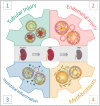Experimental Aristolochic Acid Nephropathy: A Relevant Model to Study AKI-to-CKD Transition
- PMID: 35602498
- PMCID: PMC9115860
- DOI: 10.3389/fmed.2022.822870
Experimental Aristolochic Acid Nephropathy: A Relevant Model to Study AKI-to-CKD Transition
Abstract
Aristolochic acid nephropathy (AAN) is a progressive tubulointerstitial nephritis caused by the intake of aristolochic acids (AA) contained in Chinese herbal remedies or contaminated food. AAN is characterized by tubular atrophy and interstitial fibrosis, characterizing advanced kidney disease. It is established that sustained or recurrent acute kidney injury (AKI) episodes contribute to the progression of CKD. Therefore, the study of underlying mechanisms of AA-induced nephrotoxicity could be useful in understanding the complex AKI-to-CKD transition. We developed a translational approach of AKI-to-CKD transition by reproducing human AAN in rodent models. Indeed, in such models, an early phase of acute tubular necrosis was rapidly followed by a massive interstitial recruitment of activated monocytes/macrophages followed by cytotoxic T lymphocytes, resulting in a transient AKI episode. A later chronic phase was then observed with progressive tubular atrophy related to dedifferentiation and necrosis of tubular epithelial cells. The accumulation of vimentin and αSMA-positive cells expressing TGFβ in interstitial areas suggested an increase in resident fibroblasts and their activation into myofibroblasts resulting in collagen deposition and CKD. In addition, we identified 4 major actors in the AKI-to-CKD transition: (1) the tubular epithelial cells, (2) the endothelial cells of the interstitial capillary network, (3) the inflammatory infiltrate, and (4) the myofibroblasts. This review provides the most comprehensive and informative data we were able to collect and examines the pending questions.
Keywords: AKI-to-CKD transition; animal models; aristolochic acid nephropathy; aristolochic acids; nephrotoxicants; renal fibrosis.
Copyright © 2022 Baudoux, Jadot, Declèves, Antoine, Colet, Botton, De Prez, Pozdzik, Husson, Caron and Nortier.
Conflict of interest statement
The authors declare that the research was conducted in the absence of any commercial or financial relationships that could be construed as a potential conflict of interest.
Figures



References
-
- Kjellstrand CM, Ebben J, Davin T. Time of death, recovery of renal function, development of chronic renal failure and need for chronic hemodialysis in patients with acute tubular necrosis. Trans Am Soc Artif Intern Organs. (1981) 27:45–50. - PubMed
Publication types
LinkOut - more resources
Full Text Sources

